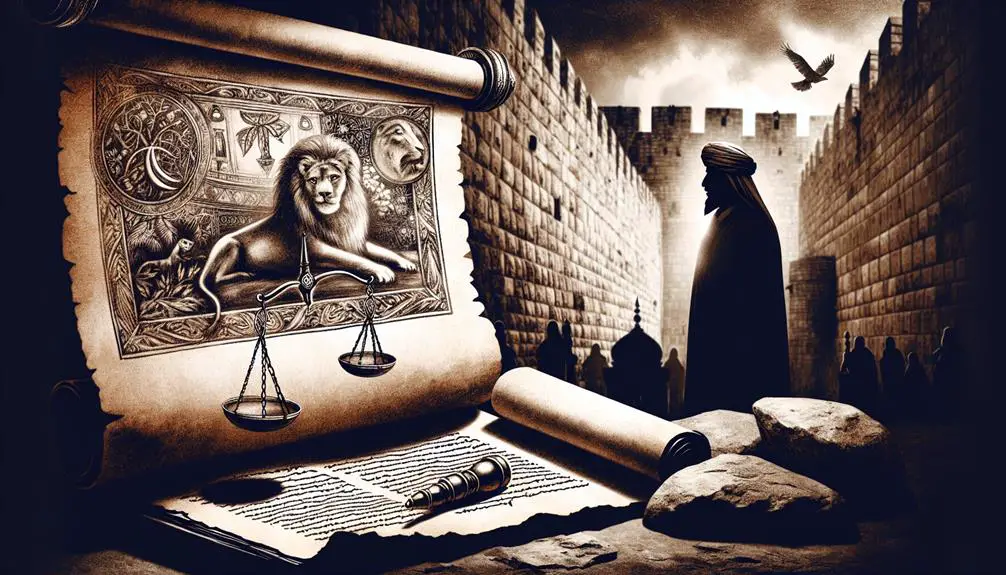Uncover the mystery behind the exclusion of Daniel 13 from the Bible and explore the debates it sparks among scholars.

Why Is Daniel 13 Not in the Bible
When you open most versions of the Bible, you'll find that the Book of Daniel ends at chapter 12, leaving you puzzled about the missing Daniel 13. This chapter, often included in what's known as the Apocrypha, tells the story of Susanna and has sparked debates among scholars and theologians for centuries.
Its exclusion from the canonical Bible raises questions about the criteria used for scriptural inclusion and the historical and theological implications of those decisions. If you're intrigued by how texts are considered sacred or not, understanding the controversy surrounding Daniel 13 offers a fascinating glimpse into the complexities of biblical canonization.
Key Takeaways
- Daniel 13, the story of Susanna, is in the Apocrypha due to debates over its canonical status.
- Criteria for scriptural inclusion, such as authenticity and theological consistency, impacted its placement outside the canonical Bible.
- Historical and theological debates, influenced by manuscript variations and early Church councils, shaped its exclusion.
- Differences between the Hebrew Bible and the Septuagint contribute to its non-inclusion in the traditional biblical canon.
Background of the Book of Daniel

The Book of Daniel, a cornerstone of biblical apocalyptic literature, presents a complex blend of historical, prophetic, and visionary narratives. You're delving into a text that not only captures the essence of Jewish perseverance during the Babylonian exile but also unfolds through a series of revelatory and symbolic stories. Key among these narratives are Nebuchadnezzar's dreams and the iconic episode of the Lion's den, each serving distinct purposes within the broader thematic framework of the book.
Nebuchadnezzar's dreams, notably the colossal statue dream in chapter 2 and the tree vision in chapter 4, are pivotal for their prophetic symbolism. They're not mere regal anxieties or divine retributions; they're intricately woven into Daniel's narrative to showcase God's sovereignty over empires and history. These dreams serve as divine communications, emphasizing that despite current circumstances, God's ultimate plan for humanity prevails.
The Lion's den, recounted in chapter 6, transcends its surface-level narrative of faith and deliverance. It's a sophisticated embodiment of the theme of divine protection and vindication. This episode not only illustrates Daniel's unwavering faith in the face of mortal danger but also acts as a symbolic confrontation between the divine and earthly powers. It reinforces the message that faithfulness to God results in deliverance and justice.
Through these narratives, the Book of Daniel offers a nuanced exploration of faith, prophecy, and divine sovereignty. It navigates the tension between present suffering and the hope for divine intervention, making it a profound piece of apocalyptic literature that resonates with themes of endurance and faithfulness amidst adversity.
Understanding Biblical Canonization

To grasp why certain texts, like Daniel 13, are absent from the Bible, one must delve into the process of biblical canonization, a critical juncture where religious, historical, and theological criteria intersected to define sacred scripture. This process wasn't uniform, resulting in variations across different Christian traditions and leading to the inclusion or exclusion of specific texts.
Central to understanding the complexity of canonization are translation issues and manuscript variations. As the Bible was translated into various languages, from Hebrew and Greek to Latin and beyond, discrepancies emerged. These translations didn't merely influence the interpretation of the words but sometimes the inclusion of entire sections. Daniel 13, for example, is present in the Septuagint, a Greek translation of Hebrew scriptures, but absent in the Jewish Tanakh, illustrating how translation choices could affect the perceived authority and canonicity of a text.
Manuscript variations further complicated the canonization process. Early Christian communities relied on different sets of scriptures, and what was considered authoritative varied widely. The discovery of numerous ancient manuscripts has highlighted the diversity of early Christian texts and underscored the fluid nature of the biblical canon during the first few centuries. These variations point to a period of intense debate and discernment among early Christians about what constituted the core of their sacred writings.
Understanding the impact of translation issues and manuscript variations is crucial to appreciating the complexity of the biblical canonization process. It reveals a multifaceted dialogue among early Christians about what texts best communicated their faith and beliefs, a dialogue that shaped the Bible as it's known today.
Criteria for Scriptural Inclusion

As you examine the reasons behind the exclusion of Daniel 13 from the Bible, it's essential to consider the criteria for scriptural inclusion.
These criteria encompass canonical authority assessment, historical context consideration, and a theological consistency check.
Each point serves as a critical lens through which texts are evaluated for their legitimacy and alignment with established biblical standards.
Canonical Authority Assessment
What criteria determine a text's inclusion in the biblical canon, and how does this apply to the case of Daniel 13? The process of canonical assessment is rigorous and multifaceted, focusing on:
- Manuscript Authenticity: This involves verifying the text's origin, ensuring it's not a later addition or forgery.
- Translation Methodologies: The techniques used to translate the scriptural texts from their original languages are closely scrutinized.
- Theological Consistency: Texts must align with established doctrinal beliefs.
- Historical Confirmation: There should be historical evidence supporting the text's context and claims.
These criteria are critical in evaluating why Daniel 13 mightn't be universally recognized within the biblical canon, highlighting the importance of a text's origin and its alignment with doctrinal and historical veracity.
Historical Context Consideration
Exploring the historical context of scriptural texts is essential in understanding their inclusion or exclusion from the biblical canon, particularly in the case of Daniel 13. You'll find that cultural variations play a significant role. Different communities may interpret texts based on their own historical and cultural backgrounds, leading to diverse forms of scripture across Christianity and Judaism.
Archaeological findings, too, shed light on the authenticity and originality of texts. Discoveries of ancient manuscripts can either support or challenge the historical veracity of a scriptural text, influencing its canonical status.
Therefore, the historical context, underscored by cultural variations and archaeological findings, critically informs the decision-making process regarding the scriptural inclusion, guiding scholars and religious leaders in understanding why certain texts, like Daniel 13, aren't universally recognized in the Bible.
Theological Consistency Check
One critical criterion for scriptural inclusion involves conducting a theological consistency check to ensure texts align with established doctrinal beliefs. This assessment scrutinizes whether a text reflects divine inspiration devoid of disproportionate cultural influences. Here's an analytical breakdown:
- Alignment with Core Doctrines: Does the text uphold the fundamental teachings central to the faith?
- Consistency in Divine Character Depiction: Is God's nature consistently represented in a manner that aligns with the rest of the canon?
- Absence of Contradictory Theology: Are there direct contradictions to established doctrines?
- Endorsement of Ethical Principles: Does the text promote ethical behavior in accordance with the moral teachings of the religion?
These criteria ensure that scriptures maintain theological integrity, reflecting divine truths rather than mere human interpretations influenced by temporal cultural contexts.
The Apocrypha Explained

The Apocrypha encompasses a collection of texts not universally recognized within the canon of the Bible, shedding light on complex theological and historical debates. Among these texts, Gnostic writings and various manuscript discoveries have prompted scholars to examine the boundaries of biblical canonization. The Apocrypha's diverse origins and content have fueled ongoing discussions about its place in religious history and practice.
Here's a brief overview to help understand the Apocrypha's relevance:
Aspect |
Insight |
|---|---|
Content Variety |
From historical accounts to wisdom literature, the Apocrypha includes a wide range of genres. |
Canonical Debate |
Disagreements among Christian denominations about the Apocrypha's canonical status persist. |
Historical Context |
These texts offer insights into Jewish and early Christian communities' beliefs and practices. |
Modern Impact |
The Apocrypha continues to influence theological study, liturgy, and artistic expressions. |
This exploration of the Apocrypha reveals it as more than a mere collection of excluded texts; it's a window into the early church's struggles with defining orthodoxy and heresy. The inclusion or exclusion of texts like those found in the Apocrypha was often influenced by their alignment with established doctrinal positions, as well as their perceived authority and authenticity.
Understanding the Apocrypha, including why certain texts like Daniel 13 are not found in the Bible, requires a nuanced appreciation of these historical, theological, and canonical considerations. Through scholarly analysis and manuscript discovery, the study of these texts continues to enrich our understanding of the religious landscape of antiquity.
Daniel 13's Content and Themes

You'll find that Daniel 13, often referred to as the story of Susanna, presents a compelling narrative rich in moral complexities.
This text not only unveils Susanna's story but also explores significant moral lessons, highlighting themes of virtue, deceit, and divine justice.
Through its narrative and thematic construction, it offers a unique lens on ethical and spiritual dilemmas, distinguishing itself from the canonical texts of Daniel.
Susanna's Story Unveiled
Delving into Daniel 13, commonly known as the story of Susanna, reveals a narrative rich in themes of virtue, temptation, and divine justice. This tale hasn't only influenced religious thought but has also left a significant mark on:
- Artistic depictions – Susanna's story has inspired countless artworks, which often explore the dramatic and moral complexities of her ordeal.
- Feminist interpretations – Scholars analyze Susanna's narrative through a feminist lens, focusing on themes of female agency, victimhood, and the male gaze.
- Theological discourse – The story is a locus for discussions about divine intervention and moral rectitude.
- Cultural narratives – Susanna's ordeal and vindication have permeated various cultural narratives, illustrating enduring themes of innocence, corruption, and redemption.
Moral Lessons Explored
Analyzing Daniel 13, one discovers a rich tapestry of moral lessons, including the virtues of steadfastness and the peril of false accusations. This narrative delves deep into ethical dilemmas, challenging you to ponder the complexities of justice and integrity.
Through its intricate character development, you witness the transformation and resilience of individuals when faced with severe moral tests. The emphasis on truth and righteousness, despite overwhelming odds, underscores the narrative's profound ethical considerations. It illuminates the consequences of deceit and the valor in maintaining one's principles.
Daniel 13, therefore, serves not only as a religious text but also as a timeless exploration of the human condition, highlighting the enduring relevance of ethical behavior and moral courage.
Historical and Theological Debates

Why does Daniel 13 not appear in the Protestant Bible, yet remains in Catholic and Orthodox canons? This question sits at the heart of historical and theological debates that have shaped the contours of biblical canonization processes. The divergence primarily stems from textual variations and manuscript discovery, which have historically influenced the inclusion or exclusion of certain texts.
- Textual Variations: Early Christian communities used diverse manuscript traditions. The Hebrew Bible, which forms the basis of the Protestant Old Testament, doesn't include Daniel 13. This chapter is found in the Septuagint, a Greek translation of Hebrew Scriptures, which Catholic and Orthodox traditions hold in high regard. The variations between these texts have led to differing views on canonical inclusion.
- Manuscript Discovery: The discovery of ancient manuscripts has occasionally fueled debates over biblical canon. New findings can either challenge or reinforce the authenticity and authority of certain texts, including Daniel 13.
- Theological Implications: The content of Daniel 13, which tells the story of Susanna, carries significant theological implications. Debates have centered on its doctrinal consistency with the rest of Scripture.
- Historical Context: The historical context in which these texts were canonized plays a crucial role. Decisions made by early Church councils and theological leaders were influenced by the socio-political and cultural milieu of their times.
These factors collectively underscore the complexity behind the canonical status of Daniel 13. Understanding these debates requires a nuanced appreciation of the intricate interplay between historical context, textual criticism, and theological considerations.
Impact on Modern Biblical Studies

The debates around the canonical status of Daniel 13 have significantly influenced contemporary biblical scholarship, prompting a reevaluation of criteria for textual inclusion and interpretation. This scrutiny has opened avenues for scholars to explore how modern interpretations and cultural influences shape the Bible we engage with today.
Aspect |
Impact |
|---|---|
Textual Inclusion |
Scholars are critically examining what texts are considered "canonical" and why, leading to a broader understanding of the historical and cultural contexts that influenced these decisions. |
Interpretive Methods |
The discussion around Daniel 13 has encouraged the development of more nuanced interpretive methods that take into account the diversity of cultural influences on biblical texts. |
Cultural Relevance |
This debate underscores the need to consider how modern cultural contexts affect our understanding and teaching of biblical texts, ensuring they remain relevant and accessible. |
In essence, the conversation about Daniel 13's exclusion has become a catalyst for a more dynamic and reflective engagement with the Bible. It's led scholars to question and redefine the boundaries of the biblical canon, not as a closed set of texts, but as a collection that reflects the evolving relationship between scripture and community. By examining how cultural influences and modern interpretations shape our view of the Bible, scholars are fostering a more inclusive and comprehensive approach to biblical studies. This has not only enriched academic discourse but also encouraged a deeper, more personal exploration of faith and spirituality in contemporary society.
Frequently Asked Questions
How Do Various Religious Traditions Interpret the Omission of Daniel 13 From Their Respective Bibles, and Does It Affect Their Faith Practices or Liturgical Readings Differently?
You're exploring how omission of Daniel 13 influences religious traditions, particularly through cultural impact and translation variations.
It's intriguing to see if this absence shifts faith practices or changes liturgical readings across different groups. By analyzing these differences, you're digging into whether traditions adapt or maintain consistency despite textual gaps.
This approach not only highlights the flexibility within religious observances but also underscores the diverse interpretations stemming from scriptural variations.
Are There Any Known Ancient Manuscripts or Texts That Reference Daniel 13 in a Way That Suggests It Was Once Considered Canonical by Certain Groups, and What Led to Its Eventual Exclusion?
You're diving into a historical whirlpool when seeking ancient manuscripts that hint at Daniel 13's once canonical status. A few texts do whisper its past relevance, yet the stiff breeze of manuscript authenticity and canonical criteria eventually blew it from the sacred pages.
Scholars dissect these ancient puzzles, analyzing why certain groups held it in esteem before it fell from grace, a testament to the shifting sands of religious orthodoxy.
How Do Contemporary Artists, Writers, and Filmmakers Incorporate the Themes and Story of Daniel 13 Into Their Works, and What Creative Liberties Are Typically Taken With the Source Material?
You'll find that modern adaptations of Daniel 13 by contemporary artists, writers, and filmmakers often weave the themes and story into their works with significant creative liberties.
These artistic interpretations explore the narrative's ethical, moral, and societal questions, embedding them in various contexts or settings that resonate with today's audiences.
Each adaptation brings a unique perspective, highlighting different aspects of the story while also inviting discussion on its relevance and interpretation.
What Are the Ethical Implications of Daniel 13's Exclusion From the Bible in Terms of Its Teachings on Justice and Integrity, and How Has This Been Debated in Modern Theological Circles?
You're diving into a complex discussion around the ethical implications of excluding a chapter from canonical texts. This debate, rooted in historical context, examines how teachings on justice and integrity are impacted.
Scholars argue its absence reshapes cultural impact and understanding of biblical justice. Analyzing these debates reveals a spectrum of interpretations, highlighting how historical and cultural contexts shape our grasp of ethical dimensions within sacred texts.
Can Linguistic Analysis of the Original Texts of Daniel 13 Provide Any Clues as to Why It Might Have Been Excluded From the Canon, Such as Inconsistencies in Language Style or Vocabulary That Differ From the Rest of the Book of Daniel?
You're delving into whether linguistic analysis can unearth reasons for its omission.
By examining textual authenticity and scrutinizing its historical context, you aim to identify any stylistic or lexical deviations that set it apart from Daniel's other chapters.
This scholarly approach seeks to uncover if these potential inconsistencies signal a misalignment with the original compositions, possibly hinting at why it wasn't included in the canonical texts.
It's a meticulous investigation into its legitimacy and fit within the scripture.
Conclusion
So, you've journeyed through the labyrinthine process of biblical canonization, untangling the complex criteria that left Daniel 13 in the shadows, a piece of the Apocrypha puzzle.
This chapter, brimming with contentious themes, has sparked historical and theological debates that could make scholars' heads spin. Its absence from the Bible profoundly influences modern biblical studies, serving as a stark reminder of the intricate dance between tradition, doctrine, and historical context that shapes what many consider the word of God.



Sign up